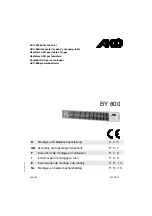
lp-441 Rev. 002 Rel. 008 Date 8.23.18
28
D. Internal Wiring Diagram
INTERNAL CONNECTION DIAGRAM
X5-2
X5-1
X5-7
X5-8
X4-2
X4-1
X4-5
X4-4
X4-6
X4-7
GREEN/WHITE
GREEN
UPPER TEMP SENSOR 1
GREY
HIGH FLUE TEMPERATURE SWITCH
PINK
ORANGE
RED
PINK
WHITE
BLACK
GREY/WHITE
X4-3
GROUND
BLOWER TACH
BLOWER 24VDC
BLOWER PWM
BLACK
GREEN
COMBUSTION
BLOWER
GAS VALVE
X5-4
X5-3
UPPER TEMP SENSOR 2
YELLOW
YELLOW/WHITE
BLOCKED VENT PRESSURE SWITCH
X3-2
X3-1
GREY/WHITE
GREY
BLACK/WHITE
BLACK
OUTDOOR SENSOR (OPT)
X3-7
X3-8
X
11-4
X
11-3
WHITE
FAN NEUTRAL
FAN HOT
X
12-2
X
12-1
120V LINE
120V NEUTRAL
BLACK
WHITE
Figure 19 - Internal Wiring Diagram
Part 8 - Gas Connections
Failure to follow all precautions could result in fire, explosion, severe
injury, or death.
Ensure the gas on which the water heater will operate is the same
type specified on the rating plate. Failure to do so could result in
water heater malfunction, property damage, personal injury, or
death.
The gas supply shall have a minimum of no less than 3.5” water column,
a maximum inlet pressure of no greater than 14” water column (350
mm), and ½ pound pressure (3.5 kPa). The entire piping system, gas
meter, and regulator must be sized properly to prevent excessive
pressure drop (greater than 0.5” WC) as stated in the National Fuel Gas
Code. This information is listed on the rating plate.
It is very important that the water heater is connected to the gas type
noted on the rating plate: “LP” for liquefied petroleum, propane gas, or
“Nat” for natural or city gas. All gas connections must be approved by
the local gas supplier or utility, in addition to the governing authority,
prior to turning the gas supply on.
If the water heater experiences a pressure drop greater than 1” WC,
the meter, regulator, or gas line is undersized or in need of service.
A manometer can be attached to the incoming gas drip leg by
removing the cap. The gas pressure must remain between 3.5”
and 14” WC during stand-by (static) mode and while in operating
(dynamic) mode at full output.
If an in-line regulator is used, it must be installed a minimum of
10 feet from the heater. It is very important that the gas line is
properly purged by the gas supplier or utility. Improper line sizing or
failure to properly purge the lines will result in ignition failure. This
problem is especially noticeable in NEW LP installations, in empty
tank situations, or when a utility company shuts off service to an
area to maintain supply lines.
Once all inspections have been performed, the piping must be leak
tested. If the leak test requirement is a higher test pressure than the
maximum gas inlet pressure, isolate the heater from the gas line
to continue leak testing. To do this, turn off the factory and field-
installed gas cocks. Failure to do so may damage the gas valve.
In the event the gas valve is exposed to a pressure greater than
½ PSI, 14” water column, the gas valve must be replaced. The gas
valve must not be replaced with a conventional gas valve under any
circumstances. As an additional safety feature, the gas valve in this
















































